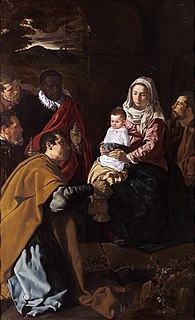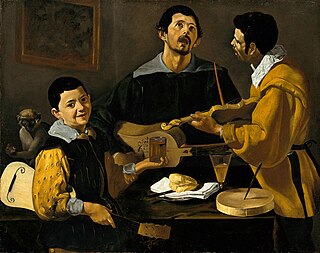 W
WThe Adoration of the Magi is a 1619 Baroque painting by the Spanish artist Diego Velázquez now held in the Museo del Prado. It shows three kings presenting gifts to the Christ child: Melchior, who kneels in the foreground; Balthazar, who stands behind him wearing a red cape and a lace collar; and Caspar, who appears between the other two. An unidentified young man who stands behind Balthazar is looking on. Kneeling near the Virgin's left shoulder is Saint Joseph. The size and format of the painting indicate that it was made for an altarpiece.
 W
WChrist in the House of Martha and Mary is an oil-on-canvas painting from Spanish artist Diego Velázquez, dating to his Seville period. Housed in the National Gallery, London, United Kingdom, it was painted in 1618, shortly after he completed his apprenticeship with Pacheco. At this time, Velázquez was experimenting with the potential of the bodegones, a form of genre painting set in taverns or kitchens which was frequently used to relate scenes of contemporary Spain to themes and stories from the Bible. Often they contained depictions of people working with food and drink.
 W
WThe Farmers' Lunch is one of the earliest paintings by the Spanish artist Diego Velázquez. Painted in oil on canvas in 1617, it combines a still life of food and drink with a depiction of three comic farmers, whose physiognomy the artist studies closely. The composition shows a younger man gesturing with his right hand to reinforce the story coming from his half-open lips, and an older man listening attentively while holding his cup up to a woman so she can refill it with wine. The still life includes fish, bread, a carrot, a lemon, and a copper vessel.
 W
WThe Kitchen Maid is one of two paired domestic paintings by Diego Rodríguez de Silva y Velázquez from his early Seville period. A wide range of dates has been suggested for its completion, although most place it between 1620 and 1622. This version is kept in the Art Institute of Chicago. The second version is held at the National Gallery of Ireland.
 W
WThe Lunch is a very early painting by Spanish artist Diego Velázquez, finished c. 1617. The work, an oil painting on canvas, is in the Hermitage Museum of Saint Petersburg.
 W
WOld Woman Frying Eggs is a genre painting by Diego Velázquez, produced during his Seville period. The date is not precisely known but is thought to be around the turn of 1618 before his definitive move to Madrid in 1623. The painting is in the Scottish National Gallery in Edinburgh. Velázquez frequently used working-class characters in early paintings like this one, in many cases using his family as models; the old woman here also appears in his Christ in the House of Martha and Mary (1618). There is some dispute about what cooking process is actually depicted with some suggesting not frying but poaching, leading to an alternative title of the painting, Old Woman Cooking Eggs or Old Woman Poaching Eggs.
 W
WThe Three Musicians is an oil painting by Diego Velázquez (1599-1660), a Spanish Baroque painter considered one of the great Spanish naturalists. It depicts three young men grouped around a dinner table playing music. It is painted in chiaroscuro, a Baroque painting technique that made use of the contrast between light and dark shadows to achieve a sense of volume.
 W
WThe Waterseller of Seville is the title of three paintings by Spanish artist Diego Velázquez, dating from 1618–1622. The original version is considered to be among the finest works of the painter's Seville period and is displayed in the Wellington Collection of Apsley House. The original version was painted by Velázquez when he was in his late teens or early twenties. Looking at this painting, there is an older man, a young boy, and a bystander in the background. The old man is handing the young boy a glass of water but, they never look at each other, nor do they make eye contact with the viewer.